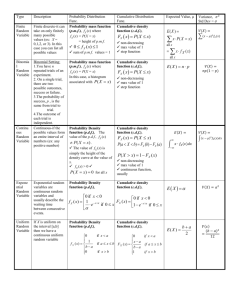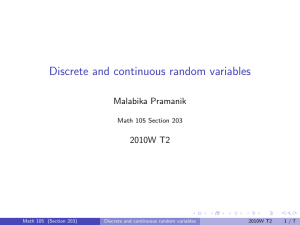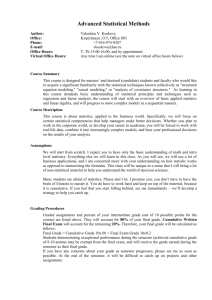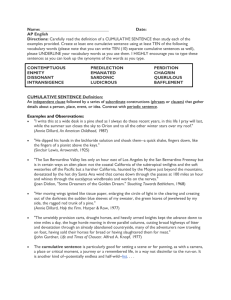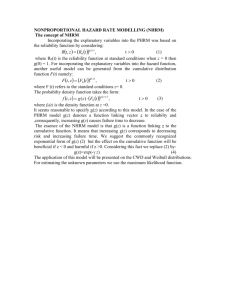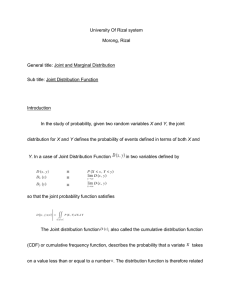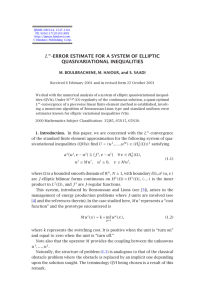14 The Cumulative Distribution Function
advertisement
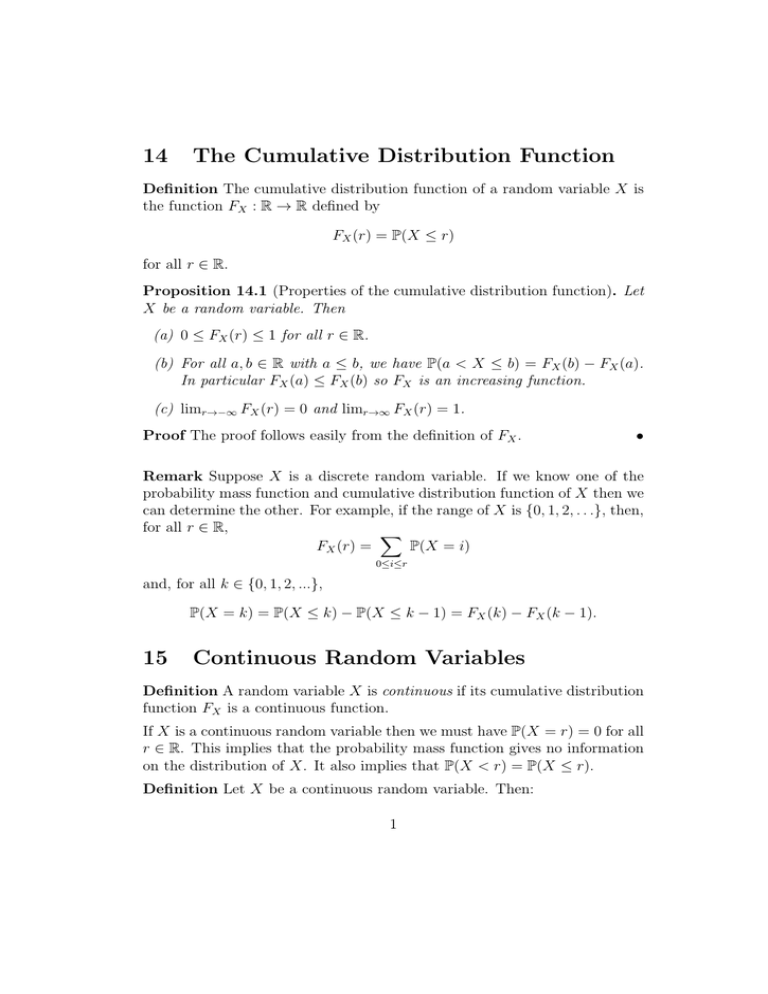
14
The Cumulative Distribution Function
Definition The cumulative distribution function of a random variable X is
the function FX : R → R defined by
FX (r) = P(X ≤ r)
for all r ∈ R.
Proposition 14.1 (Properties of the cumulative distribution function). Let
X be a random variable. Then
(a) 0 ≤ FX (r) ≤ 1 for all r ∈ R.
(b) For all a, b ∈ R with a ≤ b, we have P(a < X ≤ b) = FX (b) − FX (a).
In particular FX (a) ≤ FX (b) so FX is an increasing function.
(c) limr→−∞ FX (r) = 0 and limr→∞ FX (r) = 1.
Proof The proof follows easily from the definition of FX .
•
Remark Suppose X is a discrete random variable. If we know one of the
probability mass function and cumulative distribution function of X then we
can determine the other. For example, if the range of X is {0, 1, 2, . . .}, then,
for all r ∈ R,
∑
FX (r) =
P(X = i)
0≤i≤r
and, for all k ∈ {0, 1, 2, ...},
P(X = k) = P(X ≤ k) − P(X ≤ k − 1) = FX (k) − FX (k − 1).
15
Continuous Random Variables
Definition A random variable X is continuous if its cumulative distribution
function FX is a continuous function.
If X is a continuous random variable then we must have P(X = r) = 0 for all
r ∈ R. This implies that the probability mass function gives no information
on the distribution of X. It also implies that P(X < r) = P(X ≤ r).
Definition Let X be a continuous random variable. Then:
1
• a median of X is a number r such that FX (r) = 1/2;
• a lower quartile of X is a number r such that FX (r) = 1/4;
• an upper quartile of X is a number r such that FX (u) = 3/4;
• for any number k with 0 ≤ k ≤ 100, a kth percentile of X is a number
r such that FX (r) = k/100.
Remark The above definition also holds for discrete random variables. However, for a discrete random variable the median (and the quartiles and percentiles) may not exist. If the random variable is continuous they are guaranteed to exist. (Which result from calculus implies this?)
Definition The probability density function of a continuous random variable
X is the function fX we obtain by differentiating the cumulative distribution
function FX . So
d
fX (r) = FX (r).
dr
Note fX is not defined at points where FX is not differentiable. We can
either leave it undefined at these points or give it any reasonable values. It is
a fact (from calculus) that the cumulative distribution function of a continuous random variable is differentiable except possibly at a few “corners”, so
whatever we do will make no difference to integrals involving fX . Everything
that follows will be unaffected by the value of fX at these “bad” points.
Proposition 15.1 (Properties of the probability density function). Let X
be a continuous random variable. Then:
(a) fX (r) ≥ 0 for all r ∈ R.
∫r
(b) FX (r) = −∞ fX (t)dt for all r ∈ R.
(c) P(a < X ≤ b) = FX (b) − FX (a) =
a ≤ b.
∫∞
(d) −∞ fX (r)dr = 1.
∫b
a
fX (r)dr for all a, b ∈ R with
Proof (a) Proposition 14.1(b) tells us that FX is an increasing function,
hence its derivative is non-negative.
(b) Follows from the Fundamental Theorem of Calculus.
2
(c) Follows from (b).
(d) Follows from (c).
•
The probability density function plays a similar role in the theory of continuous random variables as the probability mass function in the theory of
discrete random variables. In particular we can use it to define the expectation and variance of a continuous random variable.
Definition Suppose X is a continuous random variable with probability
density function fX . Then
∫ ∞
E(X) =
rfX (r)dr
−∞
and, if E(X) = µ,
∫
∞
Var(X) =
−∞
(r − µ)2 fX (r)dr.
The properties of expectation and variance that we proved in the discrete
case (Propositions 11.2 and 11.3) also hold for continuous random variables.
We also have the result that, if X is a continuous random variable and
g : R → R is a continuous function, then g(X) is also a continuous random
variable and
∫ ∞
E(g(X)) =
g(r)fX (r)dr.
−∞
In particular we may use a similar proof to to that of Propositions 11.4
to show that
Var(X) = E(X 2 ) − E(X)2 .
Note In the above definitions the integrals go from −∞ to ∞. However, in
practice the probability density function is often 0 outside a smaller range
and so we can integrate over this smaller range only (see examples in notes
and on problem sheets).
3


